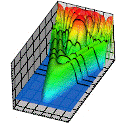Department of Physics and Astronomy: Publications and Other Research
Date of this Version
8-2015
Citation
PHYSICS OF PLASMAS 22, 093111 (2015)
Abstract
Classical relativistic Monte Carlo simulations of petawatt laser acceleration of electrons bound initially in hydrogen-like, highly-charged ions show that both the angles and energies of the laser-accelerated electrons depend on the initial ion positions with respect to the laser focus. Electrons bound in ions located after the laser focus generally acquire higher (≈GeV) energies and are ejected at smaller angles with respect to the laser beam. Our simulations assume a tightly-focused linearly-polarized laser pulse with intensity approaching 1022W/cm2. Up to fifth order corrections to the paraxial approximation of the laser field in the focal region are taken into account. In addition to the laser intensity, the Rayleigh length in the focal region is shown to play a significant role in maximizing the final energy of the accelerated electrons. Results are presented for both Ne9+ and Ar17+ target ions.
Included in
Atomic, Molecular and Optical Physics Commons, Elementary Particles and Fields and String Theory Commons, Plasma and Beam Physics Commons


Comments
Copyright (c) 2015 AIP Publishing LLC. Used by permission.